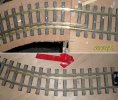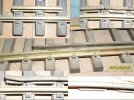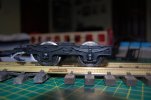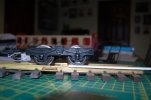yellow_cad
Registered
Thanks for all the great ideas. Most of my cars are 40' and I do have 2 foot radius turns, but these are not always where the problems occurs. The cars are Bachmann Big Haulers made from kits.
I have not checked all of the back to backs, but I surely will.
Sorry, but I still do not totally grasp the equalizing of the trucks. My trucks have the bearing housings on each side connected with a screw to the base plate that connects to the car with a pivot screw. Should I play with theses screws that attach the bearing housings to get more flexing such as a 1/4 turn and then try?
Thanks for the weight formula. I will bring the problematic cars up to weight, but I do seem to have a coupling problem that stems from too much pulling weight as it usually occurs on the second car in a consist of 7 or 8. I know about couplers in other gauges, but not in G scale.
Obviously, if a problem occurs in the same spot with different cars, then the track is the first suspect. I have a homemade track gauge and some clip ons, but would certainly invest in the aristocraft g scale track level/guage. Doing a search, any time I find one, they are out of stock. Does anyone know where one is available?
Thanks again for all of the assistance. Jim
I have not checked all of the back to backs, but I surely will.
Sorry, but I still do not totally grasp the equalizing of the trucks. My trucks have the bearing housings on each side connected with a screw to the base plate that connects to the car with a pivot screw. Should I play with theses screws that attach the bearing housings to get more flexing such as a 1/4 turn and then try?
Thanks for the weight formula. I will bring the problematic cars up to weight, but I do seem to have a coupling problem that stems from too much pulling weight as it usually occurs on the second car in a consist of 7 or 8. I know about couplers in other gauges, but not in G scale.
Obviously, if a problem occurs in the same spot with different cars, then the track is the first suspect. I have a homemade track gauge and some clip ons, but would certainly invest in the aristocraft g scale track level/guage. Doing a search, any time I find one, they are out of stock. Does anyone know where one is available?
Thanks again for all of the assistance. Jim





